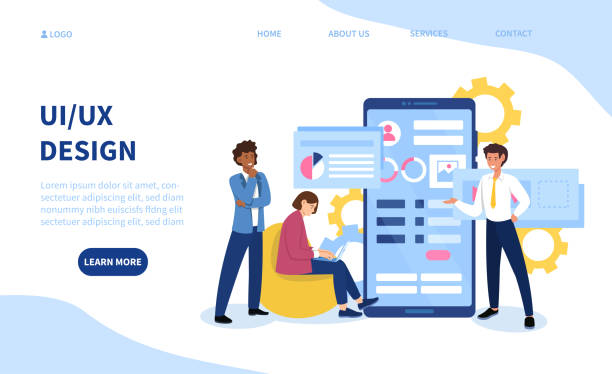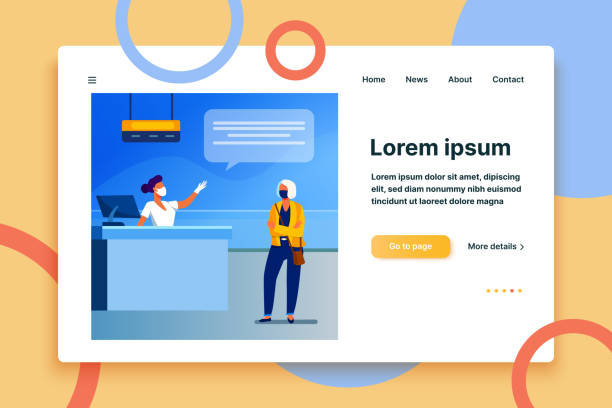Introduction to Web Transformation with Responsive Design

In today’s digital world, where internet access through various devices such as smartphones, tablets, laptops, and even smart TVs is common, the need for websites that can adapt to any screen size has become more vital than ever.
#Responsive_Website_Design or #Responsive_Web_Design, is an innovative solution to this challenge that ensures a seamless and optimized user experience on any device.
This approach is, in fact, a philosophy in web design and development that dynamically adjusts the layout and elements of a website to the user’s screen dimensions and features by utilizing flexible grids, fluid images, and Media Queries.
Before the advent of responsive website design, developers were forced to design separate versions of websites for different devices, which, in addition to increasing costs, also brought maintenance complexities.
However, by adopting the principles of responsive website design, only a single codebase is sufficient for all platforms, which is considered a huge advancement.
This transformation is not only a great technical achievement but also directly impacts the quality of user interaction with online content, ensuring that every visitor, regardless of the device they use, has the best possible experience.
This pioneering approach enables websites to be resilient against future changes in display technologies and reduces the need for frequent redesigns.
Worried about losing customers because you don’t have a professional e-commerce site?
With e-commerce website design by RasaWeb, forget these worries!
✅ Significant increase in sales and visitor-to-customer conversion rate
✅ Professional and user-friendly design that builds customer trust
⚡ Get free consultation from RasaWeb
Why is Responsive Website Design an Undeniable Necessity?

In the current era, where more than half of web traffic originates from mobile devices, the importance of responsive website design is no longer a luxury option, but an undeniable necessity for any business or organization aiming for an effective online presence.
One of the main reasons for this necessity is the significant improvement in user experience (UX).
A properly designed responsive website displays content in a readable and accessible manner, regardless of screen size, eliminating the need for zooming or horizontal scrolling.
This leads to greater user satisfaction and increased time spent on the site.
Another vital reason is its direct impact on SEO.
Google and other search engines prefer responsive websites over non-responsive ones and rank them higher in mobile search results.
Google’s “Mobile-First Indexing” algorithm explicitly states that the mobile version of your website is the basis for ranking.
This means that the lack of a responsive website design can seriously harm your site’s visibility in search results.
Economically, maintaining and updating a single version of a website is much more cost-effective than managing multiple separate versions for different devices.
These cost reductions include development, testing, and maintenance time.
Furthermore, a mobile-friendly website reduces the bounce rate and increases the conversion rate, as users experience a smooth and unimpeded journey that drives them towards the desired action (such as purchasing or signing up).
Overall, responsive design is an investment in your website’s future, ensuring its sustainability and growth in the dynamic digital environment.
Key Principles in Responsive Website Structure

For successful implementation of responsive website design, adherence to three key and fundamental principles is essential, enabling the website to display optimally on any screen size.
The first principle is the use of Fluid Grids.
Instead of using fixed pixel units for element widths, relative units like percentages or em/rem are used.
This means that the width of columns, images, and other elements adjusts based on the user’s display space width, not a fixed value.
For example, if a column occupies 10% of the page width, this ratio will be maintained on any device, and the content will scale correctly.
The second principle is Flexible Images.
Images and media should be scalable so they don’t overflow their containers and their size adjusts to the available space.
This is usually achieved by setting the `max-width: 100%;` property in CSS, which ensures that the image never becomes larger than its parent’s width but can scale down proportionally.
The third, and perhaps most important, principle is the use of Media Queries.
This CSS3 feature allows developers to apply different styles based on specific device characteristics such as screen width, height, orientation (portrait or landscape), and even resolution.
Using media queries, breakpoints can be defined, and at each breakpoint, the layout, fonts, and even the display or non-display of specific elements can be altered.
For example, it can be determined that on smaller screens, the navigation menu transforms into a hamburger icon, or columns stack vertically instead of appearing side-by-side.
Implementing these three principles together allows for the creation of a dynamic and efficient responsive design.
This approach literally makes the website “responsive” to the environment in which it is displayed, providing a consistent and high-quality experience across various devices.
These are the fundamental building blocks for any successful responsive website design.
Table 1: Common Breakpoints in Responsive Design
| Device Name/Screen Type | Approximate Width (pixels) | Purpose | Example Usage |
|---|---|---|---|
| Small Mobile | Below 320px | Ensure readability on smallest screens | Larger fonts, less padding |
| Mobile | 320px – 480px | Single-column layout | Hamburger menu, large touch targets |
| Tablet | 481px – 768px | Optimization for medium displays | 2 or 3-column layout, more complex navigation |
| Laptop/Small Desktop | 769px – 1024px | Standard desktop layout | Multiple columns, full menus |
| Desktop | 1025px – 1200px | Full content display | More complex layouts, high-quality graphics |
| Large Desktop | Above 1200px | Utilizing more space | Advanced layout settings, very high-resolution images |
Challenges and Solutions in Responsive Design

Despite the numerous advantages of responsive website design, its implementation is not without challenges, and developers often face obstacles that require intelligent solutions.
One of the most important of these challenges is Performance Management of the website.
A responsive site must load quickly on all devices, especially on mobile devices with limited internet speed.
Using high-resolution images for desktops can lead to slow loading on mobile devices.
The solution to this problem is Lazy Loading for images and image optimization (such as using next-gen image formats like WebP and optimizing size and compression).
Additionally, using optimized CSS and JavaScript and minimizing HTTP requests can help improve speed.
Another challenge is development and maintenance complexity.
Designing a website that displays correctly across all sizes and orientations requires high precision and extensive testing.
This can be time-consuming, especially in large projects with complex structures.
The solution to this challenge is to use CSS frameworks like Bootstrap or Tailwind CSS, which provide developers with ready-made tools and responsive components.
Also, the “Mobile-First” approach in design, which means designing first for the smallest screens and then adding features for larger screens, can help reduce complexity and ensure excellent performance on mobile.
Content management is also a significant challenge; some content may not display well on small screens or may take up too much space.
The solution to this problem is a responsive content strategy, which involves hiding or displaying some elements differently, and rewriting content for greater conciseness on mobile devices.
Finally, testing and debugging on multiple devices is a complex and time-consuming process.
Using browser simulator tools and testing on various physical devices is essential to ensure the correct functioning of responsive website design in all scenarios.
With careful planning and the use of appropriate tools, these challenges can be overcome, and an excellent user experience can be provided.
Is your company’s website as professional and trustworthy as it should be? With specialized corporate website design by RasaWeb, create an online presence that reflects your credibility and attracts more customers.
✅ Building a powerful and professional image for your brand
✅ Converting visitors into real customers
⚡ Get a free consultation right now!
New Tools for Implementing Responsive Design

With the evolution and prevalence of responsive website design, numerous tools and frameworks have emerged to facilitate and accelerate the development process.
These tools significantly simplify the work of developers and allow for the implementation of complex responsive designs with less coding.
One of the most popular and widely used of these tools is Bootstrap.
Bootstrap is a free and open-source CSS, JavaScript, and HTML framework that includes design templates for typography, forms, buttons, navigation, and other user interface (UI) components.
Its 12-column grid system makes implementing responsive layouts very easy.
Developers can determine how elements behave on different screen sizes simply by adding specific CSS classes.
Another framework that has gained significant popularity is Tailwind CSS.
Unlike Bootstrap, which provides ready-made components, Tailwind is a Utility-First framework.
This means it provides a set of low-level Utility classes that can be applied directly in HTML to build custom designs.
This approach offers more flexibility for unique designs and prevents “CSS Bloat”.
In addition to frameworks, CSS Preprocessors like Sass and Less also play an important role in developing responsive websites.
These tools add features like variables, functions, and Nested Rules to CSS, making CSS code writing more organized, modular, and easier, especially for managing a large volume of media queries.
Finally, testing and debugging tools are also vital.
Developers can use browser DevTools (such as Chrome DevTools) which provide the ability to simulate different devices and quickly test responsiveness.
Also, tools like BrowserStack or CrossBrowserTesting allow testing websites across hundreds of different combinations of real browsers and devices.
The combined use of these tools makes the implementation process of responsive website design more efficient and its results more reliable, helping developers to tackle complex challenges in the best possible way.
Impact of Responsive Design on SEO and Ranking

The connection between responsive website design and Search Engine Optimization (SEO) is deep and undeniable.
In fact, Google has explicitly stated for years that it considers responsive websites as a ranking factor.
The main reason responsive design helps improve SEO is Google’s “Mobile-First Indexing”.
Since 2018, Google has gradually started using the mobile version of websites for crawling, indexing, and ranking them.
This means that if your site does not have a responsive or mobile-friendly version, search engines may struggle to fully understand its content and rank it correctly.
A responsive website design, by providing a single URL for all devices, prevents duplicate content issues that might arise if separate mobile and desktop versions exist (e.g., m.example.com).
This helps search engines to assign link equity and rankings to a single URL without confusion.
Additionally, the improved user experience resulting from mobile-friendly design indirectly impacts SEO.
Responsive websites typically have lower bounce rates and longer user dwell times, as users can easily navigate the site and consume content.
These positive signals indicate to search engines that your website provides high-quality content and a good user experience, which can help improve rankings.
Page Speed is also an important SEO factor.
An optimized responsive website design helps improve loading speed by providing device-appropriate content and utilizing techniques such as image and code compression.
Tools like Google PageSpeed Insights can help you evaluate and improve your site’s performance.
Ultimately, given the continuous increase in mobile users, having a responsive website is no longer a competitive advantage but a prerequisite for maintaining and improving your position in search results.
Case Study of Responsive Design Successes

To better understand the impact and importance of responsive website design, a look at successful and influential real-world examples can be very insightful.
Many leading and well-known companies worldwide, by adopting this approach, have not only improved their user experience but also achieved significant business results.
For example, Forbes, a prominent financial and business publication, was one of the first organizations to fully migrate to responsive design.
Previously, they had a separate mobile version that was difficult and costly to manage.
By implementing a responsive website design, Forbes was able to improve the user experience across all devices while significantly reducing development and maintenance costs.
The result of this action was an increase in mobile traffic and improved user engagement.
Another example is The Guardian website, a reputable British newspaper.
With a mobile-friendly design, this newspaper was able to optimally and legibly present its news content across a wide range of devices, from smartphones to large desktops.
This decision not only helped attract new audiences but also increased the loyalty of existing readers, as they could follow the news effortlessly anywhere and on any device.
Even technology companies like Microsoft widely use responsive design on their websites to display their products and services in a manner compatible with user needs across various platforms.
This indicates that even tech giants have understood the importance of this approach.
The success of these examples clearly shows that responsive website design is not just a design trend but a smart business strategy that can help improve accessibility, increase user engagement, and ultimately, business growth.
This approach shapes a future where websites are literally “omnipresent” and function flawlessly.
Table 2: Hypothetical Comparison Before and After Implementing Responsive Design
| Metric | Before (Non-Responsive Site) | After (Responsive Design Site) |
|---|---|---|
| Mobile Traffic | 30% of total traffic | 65% of total traffic |
| Mobile Bounce Rate | 65% | 35% |
| Average Time on Site (Mobile) | 1:30 minutes | 3:45 minutes |
| Mobile Conversion Rate | 1.5% | 4.8% |
| Ranking in Mobile Search Results | Low/Variable | Significant and stable improvement |
| Website Maintenance Cost | High (multiple versions) | Medium (single codebase) |
The Future of Web Design with a Focus on Responsiveness

The evolution path of responsive website design has not ended, and with continuous advancements in web technologies and the emergence of new devices, the future of this field promises even more exciting changes and capabilities.
Beyond merely adjusting to screen size, the focus on “true responsiveness” and adaptation to the user environment is growing.
One of the significant trends is the move towards “Container Queries” in CSS.
Currently, media queries operate based on the entire viewport size, but Container Queries allow developers to apply styles based on the size of an element’s parent container.
This capability greatly enhances the modularity and flexibility of design and enables the creation of components that are responsive regardless of their placement on the page.
This is a big step for responsive website design at the component level.
Furthermore, with the expansion of Internet of Things (IoT) devices, smart displays, and wearable gadgets, the need for design approaches beyond traditional screens increases.
These devices might have very small screens or even no screens, necessitating “Adaptive” or “Context-Aware” designs.
These approaches optimize the experience based on the environment and how the user interacts with content.
Advances in CSS techniques such as CSS Subgrid and Logical Properties also help developers create more complex and responsive layouts with greater control.
Finally, the focus on Google’s “Core Web Vitals” and improving the actual performance of websites across different devices will become a top priority.
This means that the future of responsive website design is not just about aesthetics and layout, but about efficiency, speed, and creating a flawless and inclusive user experience on any platform the user might use.
These developments show that responsive design is not a static concept but is continuously evolving to meet the changing needs of the digital world.
Is your online sales not as expected? With RasaWeb, solve the problem of low sales and poor user experience forever!
✅ Increase visitor-to-customer conversion rate
✅ Create a pleasant user experience and boost customer trust
⚡ Act now for a free consultation!
Guidelines for Starting a Responsive Design Project

Starting a responsive website design project requires careful planning and adopting the right approaches from the outset to prevent problems in later stages.
The first, and perhaps most important, tip is to adopt a “Mobile-First” approach.
Instead of designing for desktop first and then trying to scale it down for mobile, first create the design for the smallest screens, and then gradually add features and complexities for larger screens.
This approach ensures that your site performs optimally on mobile and provides an excellent user experience.
The second tip is content prioritization.
On small screens, space is very limited.
Therefore, you need to decide which content elements are more crucial for mobile users and which can be hidden or displayed differently.
A responsive content strategy helps you manage content intelligently.
The third point is the correct use of fluid units and images.
Always use relative units like percentages, `em`, `rem`, or `vw/vh` for dimensions and spacing, and ensure images have `max-width: 100%;`.
Also, to optimize image loading, use the `srcset` attribute in HTML and the `
The fourth tip is continuous and comprehensive testing.
Do not rely solely on browser simulators.
Be sure to test your website on actual physical devices, including smartphones and tablets with various sizes and operating systems.
This helps you identify potential issues that might not be detectable in simulators.
Finally, do not forget Performance Optimization throughout the development process.
Minifying CSS and JavaScript files, using browser caching, and optimizing fonts can all help improve your website’s loading speed, which is a crucial factor in user experience and SEO.
By following these tips, you can implement a successful and efficient responsive website design that meets the needs of modern users.
Conclusion and the Enduring Importance of Responsive Design

In conclusion, it can be stated unequivocally that responsive website design is no longer just a fleeting trend in the web world, but an industry standard and a fundamental necessity for any business or organization aiming for an effective and sustainable presence in today’s digital space.
This approach goes beyond mere aesthetics and directly impacts user experience, website performance, and its visibility in search engines.
With the increasing number of mobile users and the diversity of internet-connected devices, your website’s ability to adapt to any screen size is no longer a competitive advantage, but a fundamental prerequisite for survival and growth.
Key advantages of responsive website design include improved seamless user experience, increased conversion rates, significant SEO improvement due to Google’s “Mobile-First Indexing” approach, reduced development and maintenance costs (by managing a single codebase), and increased Return on Investment (ROI).
This approach allows your website to be future-proof and eliminates the need for frequent redesigns with the advent of new devices.
Implementation challenges, such as performance management and development complexity, are manageable through the use of modern tools, powerful frameworks, and the adoption of correct approaches like “Mobile-First”.
By focusing on these principles, one can ensure that your website will respond to the changing needs of users and technology not only today but also in the future.
The importance of responsive website design is enduring, as its fundamental principles – focusing on flexibility and user-centricity – will always remain at the core of effective web design.
Investing in a responsive website design is, in fact, an investment in your long-term success and the sustainability of your online presence.
Frequently Asked Questions
| Question | Answer |
|---|---|
| What is Responsive Web Design? | It is a method of website design that optimizes the appearance and functionality of a website according to the screen size of the user’s device (mobile, tablet, laptop, etc.). |
| Why is responsive design important? | Due to the increasing use of various devices to access the internet, responsive design provides a better user experience, improves website SEO, and reduces maintenance costs. |
| What are the most important tools for responsive design? | Media Queries in CSS, use of relative units (such as percentage, em, rem, vw, vh), Flexible Images, and Grid Systems. |
| What role do Media Queries play in responsive design? | Media Queries allow the application of different CSS styles based on device characteristics (such as screen width, height, orientation, and screen type). |
| What is the Mobile First concept in responsive design? | It is an approach where design and development begin first for the smallest screen (mobile) and then gradually expand for larger screens (tablet, desktop). |
| Does responsive design affect website SEO? | Yes, Google prefers responsive websites because they offer a better user experience and eliminate the need for separate mobile and desktop versions, which helps improve SEO ranking. |
| What does Fluid Layout mean? | It means that the width of page elements is defined using relative units (such as percentages) instead of fixed pixel values, so they automatically adjust with changes in screen size. |
| How are Flexible Images used in responsive design? | By setting the `max-width: 100%;` property for images in CSS, it is ensured that the image never exceeds its container’s width, and its scale is maintained as the page size changes. |
| What are the differences between responsive design and adaptive design? | Responsive design uses a single layout that fluidly adapts to any screen size, whereas adaptive design uses several fixed, predefined layouts for specific screen sizes. |
| Are CSS frameworks like Bootstrap useful in responsive design? | Yes, frameworks like Bootstrap have a responsive Grid System and pre-designed components that make the process of building responsive websites much simpler and faster. |
And other services of RasaWeb advertising agency in the field of advertising
The Importance of Professional Images in Oil Producers’ Ads
Strategies to Increase Ad Views for Oil Producers on Industrial Websites
The Role of Technical Descriptions in the Success of Oil Producers’ Ads
Reviewing the Best Time to Publish Ads for Oil Producers
Increasing Producers’ Credibility with Professional Ads on Industrial Websites
And hundreds of other services in the field of internet advertising, advertising consultation, and organizational solutions
Internet Advertising | Advertising Strategy | Advertorials
🚀 Transform your business’s digital presence with RasaWeb’s internet advertising strategies and advertorials.
📍 Tehran, Mirdamad Street, next to Bank Markazi, Kazeroun Jonoubi Alley, Ramin Alley No. 6




